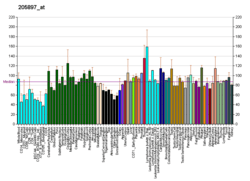NFATC4
Nuclear factor of activated T-cells, cytoplasmic 4 is a protein that in humans is encoded by the NFATC4 gene.[5][6]
Function
The product of this gene is a member of the nuclear factors of activated T cells DNA-binding transcription complex. This complex consists of at least two components: a preexisting cytosolic component that translocates to the nucleus upon T cell receptor (TCR) stimulation and an inducible nuclear component. Other members of this family of nuclear factors of activated T cells also participate in the formation of this complex. The product of this gene plays a role in the inducible expression of cytokine genes in T cells, especially in the induction of the IL-2 and IL-4.[6]
NFAT transcription factors are implicated in breast cancer, more specifically in the process of cell motility at the basis of metastasis formation. Indeed, NFAT3 (NFATc4) is an inhibitor of cell motility by blocking the expression of LCN2.[7]
Interactions
NFATC4 has been shown to interact with CREB-binding protein.[8]
See also
References
- 1 2 3 ENSG00000285485 GRCh38: Ensembl release 89: ENSG00000100968, ENSG00000285485 - Ensembl, May 2017
- 1 2 3 GRCm38: Ensembl release 89: ENSMUSG00000023411 - Ensembl, May 2017
- ↑ "Human PubMed Reference:".
- ↑ "Mouse PubMed Reference:".
- ↑ Hoey T, Sun YL, Williamson K, Xu X (May 1995). "Isolation of two new members of the NF-AT gene family and functional characterization of the NF-AT proteins". Immunity. 2 (5): 461–72. doi:10.1016/1074-7613(95)90027-6. PMID 7749981.
- 1 2 "Entrez Gene: NFATC4 nuclear factor of activated T-cells, cytoplasmic, calcineurin-dependent 4".
- ↑ Fougère M, Gaudineau B, Barbier J, Guaddachi F, Feugeas JP, Auboeuf D, Jauliac S (Apr 2010). "NFAT3 transcription factor inhibits breast cancer cell motility by targeting the Lipocalin 2 gene". Oncogene. 29 (15): 2292–301. doi:10.1038/onc.2009.499. PMID 20101218.
- ↑ Yang T, Davis RJ, Chow CW (Oct 2001). "Requirement of two NFATc4 transactivation domains for CBP potentiation". The Journal of Biological Chemistry. 276 (43): 39569–76. doi:10.1074/jbc.M102961200. PMID 11514544.
Further reading
- Rao A, Luo C, Hogan PG (1997). "Transcription factors of the NFAT family: regulation and function". Annual Review of Immunology. 15: 707–47. doi:10.1146/annurev.immunol.15.1.707. PMID 9143705.
- Crabtree GR (Mar 1999). "Generic signals and specific outcomes: signaling through Ca2+, calcineurin, and NF-AT". Cell. 96 (5): 611–4. doi:10.1016/S0092-8674(00)80571-1. PMID 10089876.
- Horsley V, Pavlath GK (Mar 2002). "NFAT: ubiquitous regulator of cell differentiation and adaptation". The Journal of Cell Biology. 156 (5): 771–4. doi:10.1083/jcb.200111073. PMC 2173310. PMID 11877454.
- Jabado N, Le Deist F, Fisher A, Hivroz C (Nov 1994). "Interaction of HIV gp120 and anti-CD4 antibodies with the CD4 molecule on human CD4+ T cells inhibits the binding activity of NF-AT, NF-kappa B and AP-1, three nuclear factors regulating interleukin-2 gene enhancer activity". European Journal of Immunology. 24 (11): 2646–52. doi:10.1002/eji.1830241112. PMID 7957556.
- Vacca A, Farina M, Maroder M, Alesse E, Screpanti I, Frati L, Gulino A (Nov 1994). "Human immunodeficiency virus type-1 tat enhances interleukin-2 promoter activity through synergism with phorbol ester and calcium-mediated activation of the NF-AT cis-regulatory motif". Biochemical and Biophysical Research Communications. 205 (1): 467–74. doi:10.1006/bbrc.1994.2689. PMID 7999066.
- Di Somma MM, Majolini MB, Burastero SE, Telford JL, Baldari CT (Sep 1996). "Cyclosporin A sensitivity of the HIV-1 long terminal repeat identifies distinct p56lck-dependent pathways activated by CD4 triggering". European Journal of Immunology. 26 (9): 2181–8. doi:10.1002/eji.1830260933. PMID 8814265.
- Molkentin JD, Lu JR, Antos CL, Markham B, Richardson J, Robbins J, Grant SR, Olson EN (Apr 1998). "A calcineurin-dependent transcriptional pathway for cardiac hypertrophy". Cell. 93 (2): 215–28. doi:10.1016/S0092-8674(00)81573-1. PMID 9568714.
- Aramburu J, Garcia-Cózar F, Raghavan A, Okamura H, Rao A, Hogan PG (Apr 1998). "Selective inhibition of NFAT activation by a peptide spanning the calcineurin targeting site of NFAT". Molecular Cell. 1 (5): 627–37. doi:10.1016/S1097-2765(00)80063-5. PMID 9660947.
- Chow CW, Davis RJ (Jan 2000). "Integration of calcium and cyclic AMP signaling pathways by 14-3-3". Molecular and Cellular Biology. 20 (2): 702–12. doi:10.1128/MCB.20.2.702-712.2000. PMC 85175. PMID 10611249.
- Graef IA, Chen F, Chen L, Kuo A, Crabtree GR (Jun 2001). "Signals transduced by Ca(2+)/calcineurin and NFATc3/c4 pattern the developing vasculature". Cell. 105 (7): 863–75. doi:10.1016/S0092-8674(01)00396-8. PMID 11439183.
- Yang T, Davis RJ, Chow CW (Oct 2001). "Requirement of two NFATc4 transactivation domains for CBP potentiation". The Journal of Biological Chemistry. 276 (43): 39569–76. doi:10.1074/jbc.M102961200. PMID 11514544.
- Yang TT, Xiong Q, Enslen H, Davis RJ, Chow CW (Jun 2002). "Phosphorylation of NFATc4 by p38 mitogen-activated protein kinases". Molecular and Cellular Biology. 22 (11): 3892–904. doi:10.1128/MCB.22.11.3892-3904.2002. PMC 133816. PMID 11997522.
- Bennasser Y, Badou A, Tkaczuk J, Bahraoui E (Nov 2002). "Signaling pathways triggered by HIV-1 Tat in human monocytes to induce TNF-alpha". Virology. 303 (1): 174–80. doi:10.1006/viro.2002.1676. PMID 12482669.
- Graef IA, Wang F, Charron F, Chen L, Neilson J, Tessier-Lavigne M, Crabtree GR (May 2003). "Neurotrophins and netrins require calcineurin/NFAT signaling to stimulate outgrowth of embryonic axons". Cell. 113 (5): 657–70. doi:10.1016/S0092-8674(03)00390-8. PMID 12787506.
- Lahti AL, Manninen A, Saksela K (May 2003). "Regulation of T cell activation by HIV-1 accessory proteins: Vpr acts via distinct mechanisms to cooperate with Nef in NFAT-directed gene expression and to promote transactivation by CREB". Virology. 310 (1): 190–6. doi:10.1016/S0042-6822(03)00164-8. PMID 12788643.
External links
- NFATC4+protein,+human at the US National Library of Medicine Medical Subject Headings (MeSH)
This article incorporates text from the United States National Library of Medicine, which is in the public domain.





